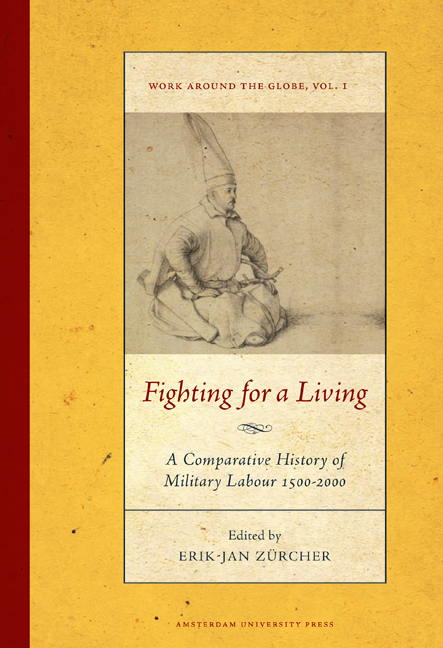Book contents
- Frontmatter
- Dedication
- Contents
- Preface
- Introduction: Understanding Changes in Military Recruitment and Employment Worldwide
- Military Labor in China, c. 1500
- From the Mamluks to the Mansabdars: A Social History of Military Service in South Asia, c. 1500 to c. 1650
- On the Ottoman Janissaries (Fourteenth-nineteenth Centuries)
- Soldiers in Western Europe, c. 1500-17901
- The Scottish Mercenary as a Migrant Labourer in Europe, 1550-1650
- Change and Continuity in Mercenary Armies: Central Europe, 1650-1750
- Peasants Fighting for a Living in Early Modern North India
- “True to Their Salt”: Mechanisms for Recruiting and Managing Military Labour in the Army of the East India Company During the Carnatic Wars in India
- “The Scum of Every County, the Refuse of Mankind”: Recruiting the British Army in the Eighteenth Century
- Mobilization of Warrior Populations in the Ottoman Context, 1750-1850
- Military Employment in Qing Dynasty China
- Military Service and the Russian Social Order, 1649-1861
- The French army, 1789-1914: Volunteers, Pressed Soldiers, and Conscripts
- The Dutch Army in Transition: From All-volunteer Force to Cadre-militia Army, 1795-1830
- The Draft and Draftees in Italy, 1861-1914
- Nation-building, War Experiences, and European Models: The Rejection of Conscription in Britain
- Mobilizing Military Labor in the Age of Total War: Ottoman Conscription Before and During the Great War
- Soldiering as Work: The All-volunteer Force in the United States
- Private Contractors in War From the 1990s to the Present: A Review Essay
- Collective Bibliography
- Notes on Contributors
“The Scum of Every County, the Refuse of Mankind”: Recruiting the British Army in the Eighteenth Century
Published online by Cambridge University Press: 12 December 2020
- Frontmatter
- Dedication
- Contents
- Preface
- Introduction: Understanding Changes in Military Recruitment and Employment Worldwide
- Military Labor in China, c. 1500
- From the Mamluks to the Mansabdars: A Social History of Military Service in South Asia, c. 1500 to c. 1650
- On the Ottoman Janissaries (Fourteenth-nineteenth Centuries)
- Soldiers in Western Europe, c. 1500-17901
- The Scottish Mercenary as a Migrant Labourer in Europe, 1550-1650
- Change and Continuity in Mercenary Armies: Central Europe, 1650-1750
- Peasants Fighting for a Living in Early Modern North India
- “True to Their Salt”: Mechanisms for Recruiting and Managing Military Labour in the Army of the East India Company During the Carnatic Wars in India
- “The Scum of Every County, the Refuse of Mankind”: Recruiting the British Army in the Eighteenth Century
- Mobilization of Warrior Populations in the Ottoman Context, 1750-1850
- Military Employment in Qing Dynasty China
- Military Service and the Russian Social Order, 1649-1861
- The French army, 1789-1914: Volunteers, Pressed Soldiers, and Conscripts
- The Dutch Army in Transition: From All-volunteer Force to Cadre-militia Army, 1795-1830
- The Draft and Draftees in Italy, 1861-1914
- Nation-building, War Experiences, and European Models: The Rejection of Conscription in Britain
- Mobilizing Military Labor in the Age of Total War: Ottoman Conscription Before and During the Great War
- Soldiering as Work: The All-volunteer Force in the United States
- Private Contractors in War From the 1990s to the Present: A Review Essay
- Collective Bibliography
- Notes on Contributors
Summary
“There are two ways of recruiting the British army”, wrote Campbell Dalrymple in his 1761 military manual,
the first and most eligible [best] by volunteers, the last and worst by a press. By the first method, numbers of good men are enrolled, but the army is greatly obliged to levity, accident, and the dexterity of recruiting officers for them; by the second plan, the country gets clear of their banditti, and the ranks are filled up with the scum of every county, the refuse of mankind. They are marched loaded with vice, villainy, and chains, to their destined corps, where, when they arrive, they corrupt all they approach, and are whipt out, or desert in a month.
In times of war, the fiscal-military state's appetite for soldiers proved voracious. The strength of the British Army in the Seven Years War swelled from roughly 31,000 men to 117,000 (on paper or 93,000 in effective strength) from 1755 to 1762, with the army in America accounting for 30,000 of these troops at its peak strength. This did not include the numerous provincial troops of the colonies, which numbered from nearly 10,000 to in excess of 20,000 men in any given year during the war. The combined figure of 40,000 to 50,000 should be doubled to arrive at total combatants when considering losses due to battlefield casualties, victims of disease or accident, desertion, and the end of service terms. These numbers were no small matter for any society, especially considering that the overwhelming majority of recruits came from Britain.
The British Army of the eighteenth century had become a modern volunteer force, with a number of qualifications. Impressment (i.e., conscription) was the most significant departure, although it only ever generated a distinct minority of soldiers. Britain also relied on mercenary forces hired from independent German polities, largely to fight for its interests on the continent, but also in the American Revolution across the Atlantic. The army arrived at this particular configuration as the result of a number of long-term historical processes, the first being political in nature. Throughout the seventeenth century, England engaged in ongoing internal conflict and regime change – civil war, regicide, creation of the Commonwealth, restoration of the monarchy, and revolution – that occupied it at home.
- Type
- Chapter
- Information
- Fighting for a LivingA Comparative Study of Military Labour 1500–2000, pp. 291 - 330Publisher: Amsterdam University PressPrint publication year: 2013



